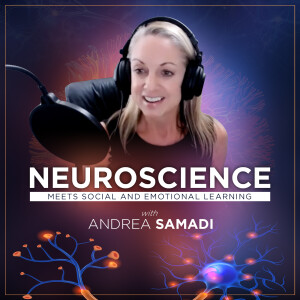
Did you know that “many people experience an increase in respiratory rate prior to any other symptoms of COVID-19?”[i]
Welcome back to the Neuroscience Meets Social and Emotional Learning Podcast for Brain Fact Friday and EPISODE #180 on “Monitoring Your Health During the Global Pandemic.”
I'm Andrea Samadi, author, and educator from Toronto, Canada, now in Arizona, and like many of you listening, have been fascinated with learning and understanding the science behind high performance strategies that we can use to improve our own productivity in our schools, our sports, and workplace environments. We can achieve outstanding and predictable outcomes with whatever it is we are working towards, when we act intentionally, with our brain in mind.
This week’s Brain Fact Friday hit me unexpectedly, when I woke up and saw something that caught my attention with the Whoop Fitness Tracker I’ve been wearing, since I interviewed Kristen Holmes on EPISODE #134 earlier this year.[ii]
BRAIN FACT FRIDAY: Changes to Respiratory Rate Are An Early Warning of COVID-19
Did you know that “many people experience an increase in respiratory rate prior to any other symptoms of COVID-19?”[iii] I woke up to an exclamation mark next to my daily vitals that I watch, and never having seen something like this, I clicked on it to see that my respiratory rate had risen, higher than usual.
Not thinking much about this, I clicked on the chart, and noticed it had jumped up significantly from 15.5 to 17.6 rpm and the note at the top of the screen said my “recent RPM measurements are significantly above your typical range. This indicates that your body may be experiencing illness, anxiety, or another condition.” I felt completely normal, but remembered reading something that WHOOP had covered with a Pro Golfer who noticed his respiratory rate jumped up prior to a positive COVID test, and I searched for that article.
WHOOP measures respiratory rate [iv] during sleep using a phenomenon called Respiratory Sinus Arrhythmia. Emily Capodilupo from Whoop explains that “when you breathe in your heart rate increases, and when you breathe out it decreases. Typically people average between 12 and 20 respirations per minute (RPM)” and this data set usually doesn’t change much on a daily basis. But when it does, it’s something to pay attention to.
Not feeling any symptoms at all at this point, and being double vaccinated, I didn’t think I had COVID, but seeing a jump in these numbers made me wonder.
When I read the article WHOOP posted last June about pro golfer Nick Watney, who noticed his respiratory rate increased (similar to mine) before he was to play in the second round of the PGA Tour’s RBC Heritage tournament[v], and this rise in respiratory rate seemed like a “pretty consistent tell-tale sign” so like Nick, I was tested, and sure enough it was positive. This was long before any symptoms had hit, allowing me to take a proactive approach to recovery and isolation, and when the symptoms did hit (a temperature increase and the worst nausea I’ve felt since pregnancy) I was prepared for them.
So, for this week’s Brain Fact Friday, did you know the science behind respiratory rate and COVID-19 and why this finding is so important?
“COVID-19 is a lower respiratory tract infection. The infected cells are the alveoli, the point of contact in your lungs to your blood. As they get damaged, your ability to get oxygen into the blood and get carbon dioxide out becomes less efficient. In order to compensate, you have to take more breaths.” (Mark Van Deusen, WHOOP.com) which explained why my respiratory rate increased. I also noticed that it was more difficult to take deep breaths, and my lungs felt like they used to feel after swimming laps of a pool (something I haven’t done in years).
While WHOOP is not a medical device, and this Week’s Brain Fact Friday is not medical advice, but to provide additional information to help you to understand the importance of staying on top of your health numbers, to be proactive, during this global pandemic when anything can change at a moment’s notice.
IMPLICATIONS: BEING PROACTIVE WITH YOUR HEALTH
I was able to catch my positive results early, allowing for a quicker recovery, minimizing exposure to others from this reading and now that it’s all over, thought it was important enough to cover the importance of measuring our numbers during this Global Pandemic. Knowing that COVID-19 “is most contagious in the 2 days before symptom onset”[vi] is a huge eye-opener for anyone to be aware enough to catch this virus early and mitigate its impact.
Just to note, while there are times that as a podcaster, I do receive products as a gift, or at a reduced price, in exchange for a product review, but this was not the case with the WHOOP device. I actually purchased it for a gift to myself (at the regular price) when I turned 50 earlier this year, so that I could stay on top of my numbers, and I’m so glad I made that choice.
During my isolation time, I was able to watch my respiratory rate return to it’s typical range, and my see my body’s recovery return to the GREEN range, which showed it was normal, and ready to return to normal activity.
To close out this week’s Brain Fact Friday, I know that knowing our numbers is important, but never thought they could save your life, and others around you. It’s fine when you wake up, consistently checking your numbers, and not seeing any change, you might think this practice would be meaningless, until that one day, like me, you notice an exclamation mark, that catches your attention, stops you in your tracks, and makes you step back, and take a closer look at what could possibly be going on with your body.
There’s nothing more important to me, than YOUR health and well-being and I wish you all well as you go into the weekend. I hope this Brain Fact Friday has been as helpful and life-changing as it was for me.
See you next week.
FOLLOW ANDREA SAMADI:
YouTube Channel: https://www.youtube.com/c/AndreaSamadi
Website https://www.achieveit360.com/
LinkedIn: https://www.linkedin.com/in/samadi/
Facebook: https://www.facebook.com/Achieveit360com
Neuroscience Meets SEL Facebook Group https://www.facebook.com/groups/2975814899101697
Twitter: https://twitter.com/andreasamadi
Instagram: https://www.instagram.com/andreasamadi/
RESOURCES:
Leveraging WHOOP Technology to Predict COVID-19 Risk June 22, 2020 by Emily Capodilupo https://www.whoop.com/thelocker/predict-covid-19-risk/
UPDATE to this article that has now been peer reviewed and published in the journal PLOS ONE. https://www.whoop.com/thelocker/predict-covid-19-risk/
REFERENCES:
[i] Knowing Your Baseline: Case Studies in Respiratory Rate in Time of COVID-19 by Mark Van Deusen https://www.whoop.com/thelocker/case-studies-respiratory-rate-covid-19/
[ii] Neuroscience Meets Social and Emotional Learning Podcast EPISODE #134 with Kristen Holmes from Whoop.com on “Unlocking a Better You: Measuring Sleep, Recovery and Strain.” https://andreasamadi.podbean.com/e/kristen-holmes-from-whoopcom-on-unlocking-a-better-you-measuring-sleep-recovery-and-strain/
[iii] Knowing Your Baseline: Case Studies in Respiratory Rate in Time of COVID-19 by Mark Van Deusen https://www.whoop.com/thelocker/case-studies-respiratory-rate-covid-19/
[iv] Understanding Respiratory Rate: What is it, What’s Normal, and Why you Should Track It by Emily Capodilupo https://www.whoop.com/thelocker/what-is-respiratory-rate-normal/
[v] Knowing Your Baseline: Case Studies in Respiratory Rate in Time of COVID-19 by Mark Van Deusen https://www.whoop.com/thelocker/case-studies-respiratory-rate-covid-19/
[vi]Leveraging WHOOP Technology to Predict COVID-19 Risk June 22, 2020 by Emily Capodilupo https://www.whoop.com/thelocker/predict-covid-19-risk/
More Episodes
Brain Fact Friday on "Training Your Brain to Self-Regulate Automatic Negative Thoughts and Emotions"
 2021-03-12
2021-03-12
 1.1k
1.1k
Resiliency Expert and Author Horacio Sanchez on "Finding Solutions to The Poverty Problem"
 2021-03-07
2021-03-07
 1.1k
1.1k
Brain Fact Friday on "Using the Reticular Activating System to Set Your Intent and Achieve it!"
 2021-03-05
2021-03-05
 1.1k
1.1k
Achieving Quantum Leap Results Using Price Pritchett's "You Squared" Principles
 2021-02-26
2021-02-26
 2.3k
2.3k
CEO of Fisher Wallace Laboratories Kelly Roman on "Wearable Medical Devices for Anxiety, Depression, and Sleep/Stress Management"
 2021-02-19
2021-02-19
 1.2k
1.2k
Behavior Analyst and Author Jessica Minahan on her book "The Behavior Code: A Practical Guide to Understanding and Teaching the Most Challenging Students"
 2021-02-13
2021-02-13
 1.8k
1.8k
Review of Neuroscientist and Best-Selling Author Dr. Caroline Leaf's "Cleaning Up Your Mental Mess" Coming March 2nd!
 2021-02-05
2021-02-05
 1.3k
1.3k
Dr. Kelley Munger and Megan Marcus from FuelEd Schools "Developing Emotionally Intelligent Educators Who Create Relationship-Driven Schools"
 2021-01-29
2021-01-29
 1.2k
1.2k
Sleep Scientist Antonio Zadra on "When Brains Dream: Exploring the Science and Mystery of Sleep."
 2021-01-24
2021-01-24
 1.1k
1.1k
The Neuroscience of Leadership: 3 Ways to Reset, Recharge and Refuel Your Brain for Your Best Year Ever
 2021-01-17
2021-01-17
 1.1k
1.1k
Aneesh Chaudhry on "Mental Health, Well-Being and Meditation: Overcoming Addiction Using Your Brain"
 2021-01-09
2021-01-09
 914
914
Lessons Learned From Our FIRST 100 Episodes
 2020-12-24
2020-12-24
 952
952
Professor Mary Helen Immordino-Yang on "The Neuroscience of Social and Emotional Learning"
 2020-12-16
2020-12-16
 1.3k
1.3k
Irene Lyon, Msc on "The Science Behind Trauma and a Healthy Immune System for an Improved Life"
 2020-12-13
2020-12-13
 1.2k
1.2k
Dr. Dawson Church on "The Science Behind Using Meditation: Rewiring Your Brain for Happiness."
 2020-12-03
2020-12-03
 1.1k
1.1k
Kirun Goy and Samuel Holston from the Brain Tools Podcast on "The Neuroscience Behind our Habits, Addictions, Love/Fears."
 2020-11-18
2020-11-18
 981
981
Dr. Daniel Stickler on "Expanding Awareness for Limitless Peak Performance, Health, Longevity and Intelligence."
 2020-11-14
2020-11-14
 862
862
Dr. Sandy Gluckman on "Reversing Children's Behavior and Mood Problems by Treating Root Causes."
 2020-11-08
2020-11-08
 1.3k
1.3k
Personal Trainer and Fitness Model Jason Wittrock on "Nutrition, Intermittent Fasting and the Ketogenic Diet."
 2020-11-03
2020-11-03
 781
781
Dr. Momo Vuyisich on "Improving the Health of Your Microbiome, Preventing and Reversing Chronic Disease."
 2020-10-31
2020-10-31
 788
788
Get your brand heard on this podcast
Join Podbean Ads Marketplace and connect with engaged listeners.
Advertise Today
Create your
podcast in
minutes
- Full-featured podcast site
- Unlimited storage and bandwidth
- Comprehensive podcast stats
- Distribute to Apple Podcasts, Spotify, and more
- Make money with your podcast
It is Free
You may also like

Mayo Clinic Talks


The Saad Truth with Dr. Saad


Positive Thinking Mind


The Jordan B. Peterson Podcast


The Mel Robbins Podcast


- Privacy Policy
- Cookie Policy
- Terms of Use
- Consent Preferences
- Copyright © 2015-2024 Podbean.com



 iOS
iOS Android
Android